
Log to Timber Optimization Software |
|
|
We understand that your primary focus is maximizing the yield from each log, and that's precisely what our software accomplishes
When it comes to cutting uniform timber from a log, the Pi2 Optimizer proves to be the right solution. With this powerful tool, all you need are the timber width and thickness. The software simplifies the cutting process with its user-friendly approach, offering the following key features: • Log cutting patterns for precise log processing. • Increased timber yield by 7-12%. • Conversion of both imperial and metric units. • Calculation reports in Excel for easy data import into your accounting system. The ability for a sawyer to compare and choose different cutting patterns provides several benefits: 1. Maximizing Yield: By evaluating different cutting patterns, a sawyer can optimize the yield of usable timber from a log or piece of wood. Some cutting patterns may result in higher overall board footage or fewer defects, maximizing the value extracted from each log. 2. Quality Enhancement: Different cutting patterns can affect the quality and characteristics of the resulting timber. By comparing patterns, the sawyer can choose one that aligns with the desired attributes such as grain pattern, stability, or appearance. 3. Waste Reduction: Certain cutting patterns can generate more waste or result in a higher proportion of low-quality timber. By comparing patterns, sawyers can minimize waste by selecting options that produce the least amount of unusable material. 4. Customer Preferences: Different customers or markets may have specific requirements or preferences for the appearance and characteristics of the timber. By comparing cutting patterns, a sawyer can tailor their production to meet those specific demands, increasing customer satisfaction and potentially commanding higher prices. 5. Efficiency and Time Savings: Certain cutting patterns may be more efficient to execute or require less time-consuming setup. By evaluating and comparing patterns, sawyers can choose the most efficient option, saving time and effort during the cutting process. Overall, having the possibility to compare different cutting patterns empowers sawyers to make informed decisions that optimize yield, enhance quality, minimize waste, meet customer requirements, and improve efficiency in their woodworking operations. |
|
